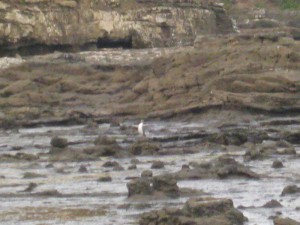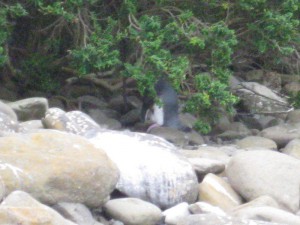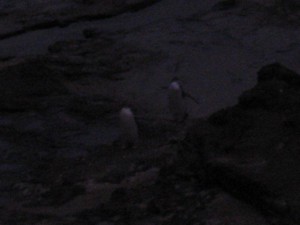The documentary “The March of the Penguins” can’t compare with experiencing the marvelous New Zealand penguins in the wild… and by “can’t compare” I mean it might be better to stay at home and watch the show.
The Setup
In Australia, I had the good fortune to go to Phillips Island National Park to see the smallest penguin species (http://www.penguins.org.au/ ). The waves literally rolled the penguins in with the surf. The cute little tykes would leap to their feet and waddle toward the brush as fast as their webbed feet would carry them. In a single evening, on the viewing boardwalk, you could watch hundreds of these impossibly energetic birds skirt past, sometimes walking right by you.
When I heard there would be Yellow-Eyed penguins in the Catlins of New Zealand, I informed my traveling companions we simply *must* see them–this was a sight that could not be missed. After my 50th rendition of the adorability of these flightless creatures, my friends agreed to a penguin outing.
The Early Arrivers
Our FarmStay hosts let us know the best penguin viewing time was between 6:00 pm and 9:30 pm at the local beach. They *guaranteed* a penguin sighting, so with wine and windbreakers in hand we set off, arriving at 5 minutes before 6:00 lest we miss a single penguin. As we climbed down the stairs to the beach, a helpful ranger informed us, “You’re too early for the penguins. They show up closer to dusk.” (aka 9:00).
Undaunted, we continued down to the beach. The wind from the sea dropped the temperature a good 20 degrees, so we sat huddled in the remnants of a Jurassic Petrified Forest as the gentle breeze tried to rip our jackets off our backs. Although we found it too cold to drink, we clumped together and eagerly watched and waited. And waited… and waited… and waited.
A gasped emerged from the gathered crowd (of ten). There–in the distance–emerged a lone penguin. Cameras came out. We zoomed and clicked countless pictures of this still animal, even though it was so far away Superman would have trouble spotting it.

We eagerly waited for some action. And waited… and waited… and waited.
Without warning, the penguin hopped. Wait!!! I had blinked and missed it. Then it hopped again. And a third time. The penguin was on a roll. I decided to take a video. Humph. The penguin must have been camera shy or tired from those three hops. Stillness resumed.
Glancing toward our left we noticed the other frozen members of our crowd staring at the bushes. We squinted, tilted our heads, brushed blowing hair from our eyes and tried to see what they were seeing.
There! The piece of driftwood on the edge of the brush was actually a Penguin butt. He had been standing there the whole time. Cameras came out. We zoomed and clicked countless pictures of this still animal, even though its back was turned and its head was hidden by some leaves.

Buoyed by our penguin sighting success–and spurred on by our digits falling off due to frostbite–we decided to grab a bite to eat and return at dusk for the main influx of penguins.
The Penguin Hoard
Two bottles of wine later we returned to find it no warmer, but a lot darker. We scurried down the steps hoping to catch the wriggling mass of penguins before the light fully faded.
There they were. Three penguins about half as close to us as the first one we saw. That first one–who had almost made it across the beach–seemed to be heading straight for three juveniles who had emerged from the brush. Nine whole penguins! (My friends were starting to doubt my Australian stories).
The slow-moving (aka hop, wait half an hour, hop) penguins, ensuing darkness and unrelenting wind all contributed to us calling it a night.

The Penguin Truth
The next day when our FarmStay hosts asked about our penguin watching, we dutifully announced that we had only seen around ten. That’s pretty good they assured us, only eleven or so penguin families nest on that beach.
Penguin Facts
For those who actually want to learn something.
- The parents head out to sea during the day to fish and return at dusk.; They have two sets of eyelids, one for swimming and one for land. Because of this, when they emerge from the sea, it takes them a while to adjust their eyesight and their body temperature–hence the slow movement.
- The juveniles wait in the brush for their parents to come feed them (regurgitated foods). Yum!
At least those are the facts I vaguely remember from our FarmStay host’s stories.
The website, http://www.catlins.org.nz/index.php?/site/yellow_eyed_penguin, provides perhaps more reliable intel:
- The yellow-eyed penguins pair for life and always return to their favourite nesting site. They nest amongst the roots of forest trees or flax within calling range, but not in sight of, the next pair of birds.
- Yellow-eyed penguins swim great distances and dive to extraordinary depths for food. There are only a few hundred of this rare penguin living on the Catlins coast.
Jurassic Petrified Forest Facts
Information about the petrified forest from http://www.curiobay.org/jurassic-petrified-forest/ :
- By the late Jurassic period, New Zealand was an extensive landmass linked to nearby parts of Gondwana (Australia/Antarctica).
- At that time Curio Bay was a broad floodplain flanked by active volcanoes which flooded the forests with volcanic debris. The lower parts of the trees were buried and turned to stone. The trunks that lie exposed were carried in by the flood and were partially buried.
- Due to the very complete nature of this process known as “silification”, the petrified wood and its texture are of an unusually high quality.
- It looks very much like real wood yet feels just like stone.
- Curio Bay is the site of one of the world’s finest fossil forests. The platform of petrified stumps, fallen trees and fern imprints are easily accessible at low tide, or can be viewed from the platform above.
